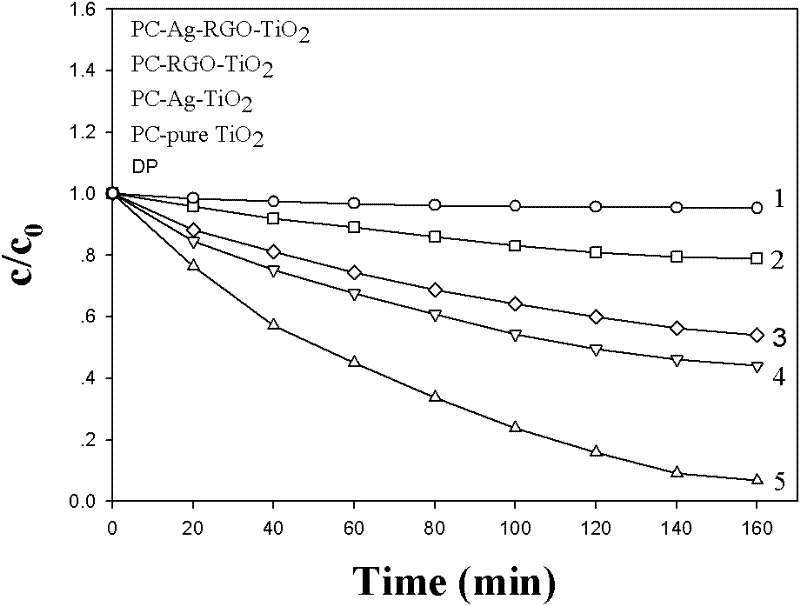Metal-graphene-titanium dioxide nanotube array photocatalyst and preparation and application method thereof
A nanotube array and titanium dioxide technology, applied in the field of composite photocatalysts, can solve the problems of difficult to effectively degrade organic pollutants, poor adsorption capacity, high recombination rate of photogenerated electrons and holes, etc.
- Summary
- Abstract
- Description
- Claims
- Application Information
AI Technical Summary
Problems solved by technology
Method used
Image
Examples
Embodiment 1
[0024] (1) Preparation of titania nanotube arrays
[0025] ① Grind the surface of the base material titanium sheet, clean it and set aside;
[0026] ② Preparation of inorganic electrolyte: the electrolyte is composed of 0.1MNaF and 0.5MNaHSO 4 The composition of the aqueous solution;
[0027] ③Under the condition of 15V DC voltage, using pure titanium sheet as the anode and platinum sheet as the cathode, the titanium dioxide nanotube array is electrolyzed in the electrolyte;
[0028] ④The titania nanotube array prepared above was calcined under aerobic conditions at 500°C for 3 hours to crystallize it into a titania nanotube array.
[0029] (2) Preparation of graphene (RGO) film
[0030] ① Preparation of graphene oxide aqueous dispersion: graphene oxide is dispersed in Na2HPO4 buffer solution with pH = 9.18, and ultrasonicated for 30 minutes before use;
[0031] ②Using the titanium dioxide nanotube array electrode as the working electrode, the platinum electrode as the cou...
Embodiment 2
[0042] In embodiment 1, AgNO3 is replaced by PdCl2, and all the other are the same as embodiment 1.
[0043] Under the same conditions in Example 1, the degradation efficiency of Pd-RGO-TiO2 nanotube array photocatalytic degradation 2,4-dichlorophenoxyacetic acid is 91.33%, and the direct photodegradation efficiency is 6.72%. Pure TiO2 Nanotube array photocatalytic The degradation efficiency is 43.99%, the photocatalytic degradation efficiency of Pd-TiO2 composite is 47.88%, and the photocatalytic degradation efficiency of RGO-TiO2 is 78.98%.
PUM
 Login to View More
Login to View More Abstract
Description
Claims
Application Information
 Login to View More
Login to View More - R&D
- Intellectual Property
- Life Sciences
- Materials
- Tech Scout
- Unparalleled Data Quality
- Higher Quality Content
- 60% Fewer Hallucinations
Browse by: Latest US Patents, China's latest patents, Technical Efficacy Thesaurus, Application Domain, Technology Topic, Popular Technical Reports.
© 2025 PatSnap. All rights reserved.Legal|Privacy policy|Modern Slavery Act Transparency Statement|Sitemap|About US| Contact US: help@patsnap.com



